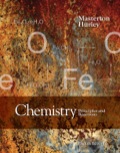
EBK CHEMISTRY: PRINCIPLES AND REACTIONS
8th Edition
ISBN: 8220100547966
Author: Hurley
Publisher: CENGAGE L
expand_more
expand_more
format_list_bulleted
Question
thumb_up100%
Chapter 20, Problem 12QAP
Interpretation Introduction
Interpretation:
The volume of sulfur dioxide produced under the given conditions should be calculated when one boxcar load of chalcopyrite ore is roasted.
Concept introduction:
The moles of any compound or element can be calculated by given formula:
Where, n is number of moles, m is given mass, and M is molar mass of the element/compound.
To obtain the volume of gases, the ideal gas equation is used as
The mass of any compound can be obtained as
The conversion factor will be used for the volumes in liter and cubic centimeter.
Expert Solution & Answer
Trending nowThis is a popular solution!

Students have asked these similar questions
3) Determine if the pairs are constitutional isomers, enantiomers, diastereomers, or mesocompounds.
(4 points)
In the decomposition reaction in solution B → C, only species C absorbs UV radiation, but neither B nor the solvent absorbs. If we call At the absorbance measured at any time, A0 the absorbance at the beginning of the reaction, and A∞ the absorbance at the end of the reaction, which of the expressions is valid? We assume that Beer's law is fulfilled.
>
You are trying to decide if there is a single reagent you can add that will make the following synthesis possible without any other
major side products:
1. ☑
CI
2. H3O+
O
Draw the missing reagent X you think will make this synthesis work in the drawing area below.
If there is no reagent that will make your desired product in good yield or without complications, just check the box under the
drawing area and leave it blank.
Click and drag to start drawing a
structure.
Explanation
Check
?
DO
18
Ar
B
© 2025 McGraw Hill LLC. All Rights Reserved. Terms of Use | Privacy Center | Accessibility
Chapter 20 Solutions
EBK CHEMISTRY: PRINCIPLES AND REACTIONS
Ch. 20 - Write a balanced equation to represent the...Ch. 20 - Write a balanced equation to represent the...Ch. 20 - Write a balanced equation to represent (a) the...Ch. 20 - Prob. 4QAPCh. 20 - Prob. 5QAPCh. 20 - Prob. 6QAPCh. 20 - Prob. 7QAPCh. 20 - Prob. 8QAPCh. 20 - Prob. 9QAPCh. 20 - Zinc is produced by electrolytic refining. The...
Ch. 20 - Prob. 11QAPCh. 20 - Prob. 12QAPCh. 20 - Prob. 13QAPCh. 20 - Prob. 14QAPCh. 20 - Prob. 15QAPCh. 20 - Prob. 16QAPCh. 20 - To inflate a life raft with hydrogen to a volume...Ch. 20 - What mass of KO2 is required to remove 90.0% of...Ch. 20 - Prob. 19QAPCh. 20 - Prob. 20QAPCh. 20 - Prob. 21QAPCh. 20 - Prob. 22QAPCh. 20 - Balance the following redox equations. (a)...Ch. 20 - Balance the following redox equations. (a)...Ch. 20 - Prob. 25QAPCh. 20 - Prob. 26QAPCh. 20 - Prob. 27QAPCh. 20 - Using Table 17.1 (Chapter 17) calculate E° for (a)...Ch. 20 - Using Table 20.4, calculate, for the...Ch. 20 - Prob. 30QAPCh. 20 - Prob. 31QAPCh. 20 - Prob. 32QAPCh. 20 - Prob. 33QAPCh. 20 - The equilibrium constant for the reaction...Ch. 20 - Using data in Appendix 1, estimate the temperature...Ch. 20 - A 0.500-g sample of zinc-copper alloy was treated...Ch. 20 - Prob. 37QAPCh. 20 - Prob. 38QAPCh. 20 - Iron(II) can be oxidized to iron(III) by...Ch. 20 - Prob. 40QAPCh. 20 - Prob. 41QAPCh. 20 - Rust, which you can take to be Fe(OH)3, can be...Ch. 20 - Prob. 43QAPCh. 20 - Prob. 44QAPCh. 20 - Prob. 45QAP
Knowledge Booster
Similar questions
- Don't use ai to answer I will report you answerarrow_forwardConsider a solution of 0.00304 moles of 4-nitrobenzoic acid (pKa = 3.442) dissolved in 25 mL water and titrated with 0.0991 M NaOH. Calculate the pH at the equivalence pointarrow_forwardWhat is the name of the following compound? SiMe3arrow_forward
- K Draw the starting structure that would lead to the major product shown under the provided conditions. Drawing 1. NaNH2 2. PhCH2Br 4 57°F Sunny Q Searcharrow_forward7 Draw the starting alkyl bromide that would produce this alkyne under these conditions. F Drawing 1. NaNH2, A 2. H3O+ £ 4 Temps to rise Tomorrow Q Search H2arrow_forward7 Comment on the general features of the predicted (extremely simplified) ¹H- NMR spectrum of lycopene that is provided below. 00 6 57 PPM 3 2 1 0arrow_forward
arrow_back_ios
SEE MORE QUESTIONS
arrow_forward_ios
Recommended textbooks for you
 Chemistry: The Molecular ScienceChemistryISBN:9781285199047Author:John W. Moore, Conrad L. StanitskiPublisher:Cengage Learning
Chemistry: The Molecular ScienceChemistryISBN:9781285199047Author:John W. Moore, Conrad L. StanitskiPublisher:Cengage Learning Chemistry: Principles and ReactionsChemistryISBN:9781305079373Author:William L. Masterton, Cecile N. HurleyPublisher:Cengage Learning
Chemistry: Principles and ReactionsChemistryISBN:9781305079373Author:William L. Masterton, Cecile N. HurleyPublisher:Cengage Learning Chemistry: Principles and PracticeChemistryISBN:9780534420123Author:Daniel L. Reger, Scott R. Goode, David W. Ball, Edward MercerPublisher:Cengage Learning
Chemistry: Principles and PracticeChemistryISBN:9780534420123Author:Daniel L. Reger, Scott R. Goode, David W. Ball, Edward MercerPublisher:Cengage Learning ChemistryChemistryISBN:9781305957404Author:Steven S. Zumdahl, Susan A. Zumdahl, Donald J. DeCostePublisher:Cengage Learning
ChemistryChemistryISBN:9781305957404Author:Steven S. Zumdahl, Susan A. Zumdahl, Donald J. DeCostePublisher:Cengage Learning Chemistry: An Atoms First ApproachChemistryISBN:9781305079243Author:Steven S. Zumdahl, Susan A. ZumdahlPublisher:Cengage Learning
Chemistry: An Atoms First ApproachChemistryISBN:9781305079243Author:Steven S. Zumdahl, Susan A. ZumdahlPublisher:Cengage Learning

Chemistry: The Molecular Science
Chemistry
ISBN:9781285199047
Author:John W. Moore, Conrad L. Stanitski
Publisher:Cengage Learning

Chemistry: Principles and Reactions
Chemistry
ISBN:9781305079373
Author:William L. Masterton, Cecile N. Hurley
Publisher:Cengage Learning

Chemistry: Principles and Practice
Chemistry
ISBN:9780534420123
Author:Daniel L. Reger, Scott R. Goode, David W. Ball, Edward Mercer
Publisher:Cengage Learning

Chemistry
Chemistry
ISBN:9781305957404
Author:Steven S. Zumdahl, Susan A. Zumdahl, Donald J. DeCoste
Publisher:Cengage Learning

Chemistry: An Atoms First Approach
Chemistry
ISBN:9781305079243
Author:Steven S. Zumdahl, Susan A. Zumdahl
Publisher:Cengage Learning
